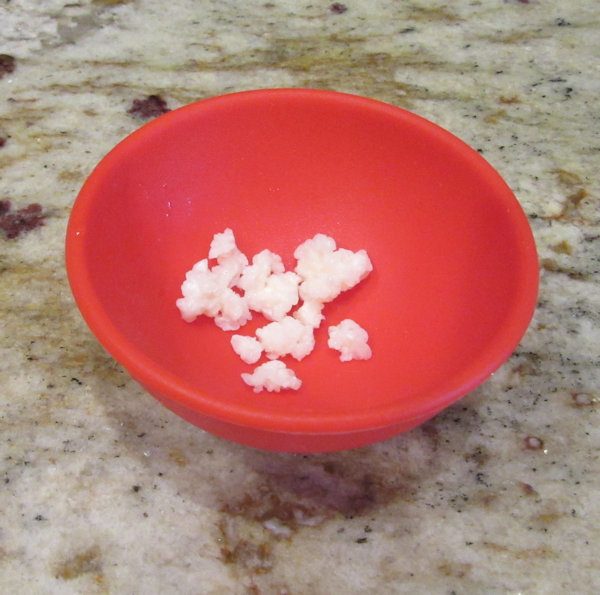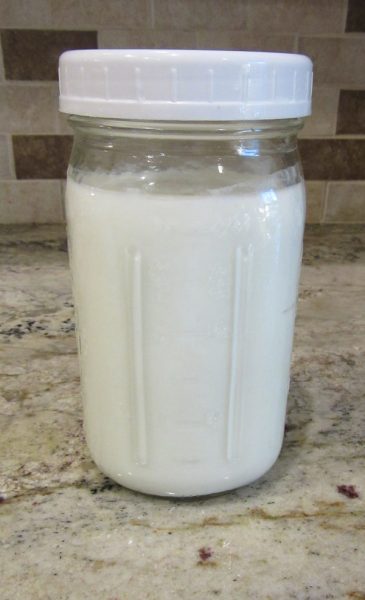Milk kefir is very similar to yogurt . . only more like a liquid yogurt. If you love plain, unsweetened yogurt, you would probably like milk kefir. I love buttermilk and I think it tastes quite similar to buttermilk, especially if I add a little salt.
It is supposed to have all kinds of health benefits but since I’m not a doctor or a nutritionist .. if you’re interested in that aspect, please google “health benefits of milk kefir” and make your own decisions.
In order to make it, you start with kefir “grains”. When added to milk, preferably cold, whole milk, the yeast and bacteria in the grains ferment the milk, while preventing it from spoiling, souring or curdling during the process. The best temperature is said to be between 60º and 90º but I found that even with the a/c on, on the days my kitchen was near 80º, I had some issues with the milk curdling before it became fermented so my preferred kitchen temp for this process (and for my working comfort) is 70º to 74º. The warmer the temp, the faster the milk will ferment.
Shown above are about 1 tablespoon of grains. They will multiply and after 5 or 6 batches, you may need to divide them. If you have too many grains, the milk ferments too quickly and you’ll be over run with milk kefir (I’m there!).
Hopefully you can see that it’s a bit thicker than most buttermilk and a bit thinner than most yogurt.
Milk kefir is much easier to make than either yogurt or buttermilk. Simply start with about 1 teaspoon of grains per cup of milk. Place it all in a jar, with a coffee filter or paper towel on top, secured by a rubberband, and let it sit for about 24 hours. Strain out the grains, put them in a fresh cup of milk, put the already fermented milk in the fridge til ready to use.
The grains can be ordered from Cultures for Health directly or, they usually have them on Amazon (quicker shipping if you have Prime). I’ve ordered from both. Recently, I had strained out the grains, put them back in a jar, got sidetracked and when I went back to the kitchen, Vince had dumped the jar . . grains and all . . in a sink full of dirty dishwater so I had to order new grains! 🙁
Ways I use milk kefir:
- Drink as buttermilk with a little salt added. Since I like buttermilk, I find this quite good. If you don’t like buttermilk and/or yogurt, you might not like this. If you want it to taste more like storebought buttermilk, add just a little salt.
- Use as a substitute for buttermilk when cooking. It makes some fantastic biscuits!
- Use as a base for salad dressing. For the longest time, I’ve used yogurt with a little vinegar and then added the spices. The kefir works just the same . . without the vinegar.
- Smoothies. I love it in smoothies. I usually add frozen figs, fruit (banana or blueberries or strawberries or pear or peach — whatever we have on hand) and a bit of kale or spinach, and about half a cup of quick cooking oats. If the fruit isn’t real sweet . . since I love sweet . . I’ll sometimes add a bit of honey to my smoothie.
One thing for sure – on these warm days, the kefir is producing more than I can use so I simply put the grains on “vacation” by placing the in about a cup of milk and sticking it in the fridge til I’ve used up some of the accumulated kefir. When ready to make it again, I’ll simply take the jar out of the fridge and depending on how long it’s been in there, either let the milk they’ve been sitting in ferment, or drain the grains and add fresh milk and start the process over again.




Sherrill Pecere says
My hubby had gotten some grains from a co-worker’s wife and brought them home and started. It just sounded absolutely gross to me and upon seeing it was absolutely sure it was gross (not a buttermilk or unflavored yogurt fan either). No way was I going to try that nastiness but he liked it. I don’t get into most of that kinda stuff but glad you like it!
pattilynn9 says
Oh, I may try this. When I read that you can put it “on vacation” – I like that! Sometimes I get tired of taking care of ongoing foods.